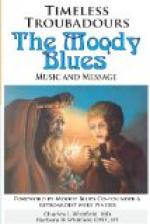“Lady, rose without thorn, sweet above all flowers, dry rod bearing fruit, earth bringing forth fruit without toil, star, mother of the sun, nurse of thine own Father, in the world no woman is like to thee, [94] neither far nor near.
Lady, virgin pure and fair before the birth was and afterwards the same, Jesus Christ our Saviour received human flesh in thee, just as without causing flaw, the fair ray enters through the window-pane when the sun shines.
Lady, star of the sea, brighter than the other stars, the sea and the wind buffet us; show thou us the right way: for if thou wilt bring us to a fair haven, ship nor helmsman fears not tempest nor tide lest it trouble us.”
CHAPTER VII [95]
THE TROUBADOURS IN ITALY
To study the development of troubadour literature only in the country of its origin would be to gain a very incomplete idea of its influence. The movement, as we have already said, crossed the Pyrenees, the Alps and the Rhine, and Italy at least owed the very existence of its lyric poetry to the impulse first given by the troubadours. Close relations between Southern France and Northern Italy had existed from an early period: commercial intercourse between the towns on the Mediterranean was in some cases strengthened by treaties; the local nobles were connected by feudal ties resulting from the suzerainty of the Holy Roman Empire. Hence it was natural for troubadours and joglars to visit the Italian towns. Their own language was not so remote from the Italian dialects as to raise any great obstacle to the circulation of their poetry and the petty princes of Northern Italy lent as ready an ear to troubadour songs as the local lords in the South of France. Peire Vidal was at the court of the Marquis of Montferrat so early as 1195; the Marquis of Este, the Count of San Bonifacio at Verona, the Count of [96] Savoy at Turin, the Emperor Frederick II. and other lords of less importance offered a welcome to Provencal poets. More than twenty troubadours are thus known to have visited Italy and in some cases to have made a stay of considerable length. The result was that their poetry soon attracted Italian disciples and imitators. Provencal became the literary language of the noble classes and an Italian school of troubadours arose, of whom Sordello is the most remarkable figure.
Raimbaut de Vaqueiras, who spent a considerable part of his career (1180-1207) with the Marquis of Montferrat, belongs as a troubadour quite as much to Italy as to Southern France. He was the son of a poor noble of Orange and became a troubadour at the court of William IV. of Orange; he exchanged tensos with his patron with whom he seems to have been on very friendly terms and to whom he refers by the pseudonym Engles (English), the reason for which is as yet unknown. Some time later than 1189, he left the court of Orange, apparently in consequence of a dispute with his patron and made his way to Italy, where he led a wandering life until he was admitted to the court of the Marquis of Montferrat. To this period of his career belongs the well-known poem in which he pays his addresses to a Genoese lady.




